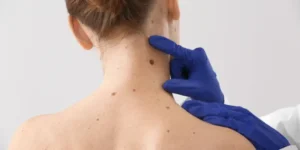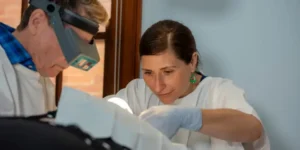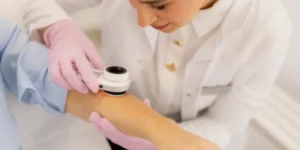Skin Cancer Checks at the Clinic: Your Guide to Checking for Skin Cancer
Checking for skin cancer starts with knowing your ABCDEs: Asymmetry, Border, Colour, Diameter, and Evolution. Learn more about these key signs and how to spot them on your skin.
ABCDE melanoma detection guide
The ABCDE guide helps spot melanoma early. It’s a simple tool anyone can use to check their skin.
- A – Asymmetry: Look for moles with uneven shapes. One half should match the other.
- B – Border: Check for jagged or blurred edges. Healthy moles have smooth, even borders.
- C – Colour: Watch for moles with many colours. Normal moles are usually one shade.
- D – Diameter: Measure moles larger than 6mm across. Most melanomas are bigger than this.
- E – Evolving: Note any changes in size, shape, or colour. Healthy moles stay the same over time.
- New moles: Keep an eye out for new spots on your skin. Adults rarely get new moles.
- Size increase: Track moles that grow quickly. Rapid growth can signal cancer.
- Notched outlines: Spot moles with uneven or notched edges. These need a doctor’s check.
- Colour shifts: Watch for moles that change colour or have many shades. This can mean trouble.
- Raised spots: Feel for moles that become bumpy or raised. Flat moles shouldn’t change shape.
- Itchy or bleeding moles: Pay attention to moles that itch, bleed, or crust over. These need a skin check.
Identifying non-melanoma skin cancers
Non-melanoma skin cancers are common but less dangerous than melanoma. They include basal cell carcinoma (BCC) and squamous cell carcinoma (SCC).
- Basal cell carcinoma (BCC):
- Appears as lumps or scaly areas
- Grows slowly and rarely spreads
- Most common type of skin cancer
- Often found on sun-exposed areas
- Squamous cell carcinoma (SCC):
- Looks like thick, scaly spots
- Can grow quickly and may spread if left untreated
- More common in people over 50
- Usually found on face, ears, hands, and arms
- Risk factors:
- Fair skin
- Lots of moles
- UV exposure from sun or tanning beds
- Weak immune system
- Past skin cancer history
- Prevention tips:
- Use sunscreen daily
- Wear protective clothing
- Avoid peak sun hours
- Get regular skin checks
- Early detection:
- Check your skin monthly
- Look for new or changing spots
- See a doctor for any concerns
- Book a yearly skin exam at Skin Cancer Hub
What to Expect During a Skin Cancer Clinic Visit

A skin cancer clinic visit involves a full-body check and chat about your skin health. Read on to learn more about what happens during your appointment at Skin Cancer Hub.
Full-body skin examination process
A full-body skin check at Skin Cancer Hub takes about 15 minutes. The doctor will ask you to undress to your underwear. They’ll use a special tool called a dermatoscope to look closely at your skin.
This tool helps spot any odd moles or marks.
The doctor checks every part of your body, from your scalp to your toes. They’ll pay extra attention to areas that get more sun. These include your face, ears, neck, arms, and legs.
The doctor might take photos of any spots that need watching. This helps track changes over time.
Early detection is key. A thorough skin check can spot problems before they become serious, says Dr Steele from Skin Cancer Hub.
Consultation and follow-up recommendations
During your skin check, the doctor will talk about your results. They’ll explain any spots that need watching or treating. If you need more tests, they’ll set those up for you. The doctor will also give you tips on how to protect your skin.
Your doctor will tell you when to come back. This depends on your skin cancer risk. Some people need checks every 3-6 months. Others can wait a year. Skin Cancer Hub offers reminders to help you keep track.
Regular checks are key to catching skin cancer early.
1. Why Are Regular Skin Checks Important in Australia?
Australia has one of the highest rates of skin cancer globally due to its high levels of UV radiation. Skin cancer affects people of all ages, and many Australians spend time outdoors, increasing their exposure to harmful sun rays. This high UV exposure leads to cumulative skin damage, putting Australians at a greater risk of developing melanoma, basal cell carcinoma (BCC), and squamous cell carcinoma (SCC).
Preventing Serious Health Issues
Regular skin checks can help identify suspicious lesions early, increasing the chances of successful treatment. For those with high sun exposure, regular checks are essential to detect cancerous and precancerous lesions before they become a serious health threat. In Australia, where the risk of skin cancer is heightened, a proactive approach to skin health can genuinely save lives.
2. What to Expect at a Skin Cancer Clinic Appointment
Booking a skin cancer check at a skin clinic is a straightforward yet essential process. During your appointment, a doctor will examine your skin closely, looking for any signs of abnormal spots, moles, or lesions. This examination often involves using a dermatoscope for magnification and a clearer view of any suspicious areas.
The Importance of a Head-to-Toe Examination
In a typical skin cancer check, you may be required to undress to allow the doctor a comprehensive view of all areas of the skin. This head-to-toe examination ensures that no spot is missed, as skin cancer can arise in unexpected areas. The doctor will assess any suspicious moles or lesions and inform you of any findings that may require further analysis or a biopsy.
3. How to Identify Suspicious Moles and Lesions
Being aware of changes in your skin is crucial for early skin cancer detection. Some common signs of a suspicious mole include irregular shape, uneven colour, and changes in size. A suspicious spot that is raised, dark, or doesn’t heal should also be examined by a doctor.
Key Characteristics of Abnormal Moles
- Asymmetry: If one half of the mole does not match the other, it may be a sign of an abnormal mole.
- Border Irregularity: Moles with blurred or irregular borders can be suspicious.
- Colour Changes: Variations in colour within a mole can indicate early stages of melanoma.
Regular checks at a skin clinic help to identify cancerous spots early, but you can monitor changes yourself and report any concerns during your appointment.
4. What is a Full-Body Skin Cancer Check?
A full-body skin cancer check involves examining the entire skin surface for signs of abnormalities. This total body approach helps in the early detection of lesions that may not be visible during self-checks. During a full-body examination, the doctor will assess any spots, moles, or lesions from head to toe.
Benefits of a Comprehensive Skin Check
Full-body checks are highly effective in identifying both visible and hidden skin cancers. By routinely examining all areas of the skin, these checks provide a more thorough assessment of your skin health, reducing the risk of undetected cancer. Regular full-body checks are especially valuable for those at a higher risk due to sun exposure or family history.
5. Who is at Higher Risk for Developing Skin Cancer?
Certain factors can increase a person’s risk of skin cancer. Those who spend extensive time outdoors, have fair skin, or have a family history of melanoma are at higher risk. Queensland and New South Wales, regions with high UV exposure, have some of the highest rates of skin cancer in the world.
High-Risk Factors for Skin Cancer
- Genetics: Individuals with a family history of skin cancer are more susceptible to developing it themselves.
- Skin Type: Fair-skinned people with light hair and eyes are at greater risk due to lower levels of melanin.
- Sun Exposure: Australians who spend significant time in the sun without protection are at increased risk.
For those at higher risk, regular skin checks are highly recommended every 12 months to ensure early detection and prevent complications.
6. How Does a Dermatoscope Aid in Skin Cancer Detection?
A dermatoscope is a powerful tool that doctors use to get a closer look at moles and lesions. This device provides magnification, allowing for a detailed analysis of the structure and colour of skin lesions. A dermatoscope’s magnified view enables doctors to differentiate between benign and potentially malignant moles.
Advantages of Using Dermoscopy
Using dermoscopy, doctors can detect suspicious moles with greater accuracy. The magnified view allows for detailed analysis, which helps in distinguishing cancerous lesions from benign spots. Many clinics also use digital imaging to store images, which is beneficial for tracking changes in lesions over time.
7. Why Book an Appointment for a Skin Check Every 12 Months?
Routine skin checks are essential for all age groups, whether young or old. By scheduling an annual check-up, individuals are more likely to catch suspicious lesions at an early stage. If you’re living in a high-risk area, an annual skin check is an investment in long-term health.
Regular Monitoring for Better Outcomes
Annual skin checks allow doctors to assess any changes in moles, freckles, and spots from year to year. This routine makes it easier to detect abnormalities, and even if something suspicious arises, early diagnosis can lead to more effective treatment. Book an appointment to ensure your skin is regularly monitored by professionals.
8. Frequently Asked Questions About Skin Cancer Screening
Many people have frequently asked questions about skin cancer screening, especially regarding the process and what to expect. Here are answers to some common questions.
Common Concerns
- Will I Need a Biopsy? If a suspicious mole or lesion is detected, the doctor may recommend a biopsy to determine if it is cancerous.
- Do I Need to Prepare for the Appointment? Wear loose clothing and avoid wearing makeup or nail polish, as they can obscure spots during the check.
- Is Skin Cancer Screening Painful? The examination is non-invasive and typically painless, although a biopsy, if required, may involve a small injection of anaesthetic.
Regular screenings can be the difference between early intervention and advanced treatment, so don’t hesitate to ask questions at your appointment.
9. What Are the Common Signs of Melanoma Skin Cancer?
Melanoma is a dangerous form of skin cancer that can spread quickly if left untreated. Recognising early signs is essential, as melanoma often affects areas not commonly exposed to the sun, such as the scalp or soles of the feet.
Recognising Melanoma
- Dark or Multi-Coloured Moles: Melanomas often have more than one shade, making them distinct from benign moles.
- Itching or Bleeding: Moles that itch, bleed, or develop a crust should be checked by a doctor.
- Rapid Growth: Melanomas can grow quickly, so any mole that seems to expand over a short period is worth examining.
If you notice these signs, booking an appointment at a skin clinic for a melanoma skin check is highly recommended.
10. How to Protect Your Skin and Lower Your Risk
While regular checks are crucial, preventive measures can also lower your risk of skin cancer. Daily sun protection habits, such as applying sunscreen and wearing protective clothing, can help prevent cumulative damage to your skin.
Prevention Tips
- Sunscreen Application: Apply broad-spectrum SPF daily and reapply every two hours if outdoors.
- Protective Clothing: Wear hats, long sleeves, and sunglasses to minimise sun exposure.
- Avoid Peak Sun Hours: Stay indoors or seek shade between 10 am and 4 pm when UV rays are strongest.
By incorporating these habits into your routine, you can significantly reduce your risk of developing skin cancer, making regular check-ups a proactive part of your skin health strategy.
Summary: Key Takeaways for Protecting Your Skin Health
- Routine Skin Checks Save Lives: Regular skin checks help detect skin cancer early, when it is most treatable.
- Identify Suspicious Lesions Promptly: Monitor your skin for any suspicious lesions and report changes to a professional.
- Dermoscopy Enhances Detection: Clinics use dermatoscopes to achieve accurate diagnosis through magnification and imaging.
- Annual Appointments are Essential: High-risk individuals should consider a full-body skin check at least every 12 months.
- Practice Preventive Skin Care: Daily sun protection and self-checks reduce your risk of skin cancer.
With proactive care and regular check-ups, you can protect your skin from the dangers of melanoma and other skin cancers. Book an appointment today to start your journey towards lifelong skin health.
Conclusion
Regular skin checks save lives. Book a full-body exam at Skin Cancer Hub today. Learn the ABCDE method for self-checks between visits. Protect your skin from UV rays daily. Early detection leads to better outcomes – don’t delay your next skin cancer screening.
FAQs
1. How often should Aussies get a skin cancer check?
Most folks should get a full skin check yearly. But if you’re at higher risk – fair skin, lots of moles, or family history – see your GP more. Early detection’s key!
2. What happens during a skin cancer check at the clinic?
The doc will do a full body check, using a special skin microscope. They’ll look for any odd spots, freckles, or moles. If something’s suss, they might snap a pic or do a biopsy.
3. Can I check my own skin between clinic visits?
Absolutely! Use a mirror to check your whole body monthly. Look for changes in colour, size, or shape of moles. Can’t reach? Ask a mate to help. Spot something weird? Book in with your GP pronto.
4. Are some people more likely to get skin cancer?
Yep. Fair-skinned folks, those with lots of moles, or a history of sunburns are at higher risk. But anyone can get it – even dark-skinned people. Sun protection’s crucial for everyone.
5. How can I lower my chances of skin cancer?
Slip, slop, slap! Wear sunscreen, cover up, and avoid peak UV times. Download the free SunSmart app for UV alerts. And remember, no tan is safe – skip the solarium!
6. Does Medicare cover skin cancer checks?
Medicare covers some skin cancer services, but it depends. Chat with your GP about what’s covered. Some clinics bulk bill, others have out-of-pocket costs. Early detection can save your life… and your wallet!





